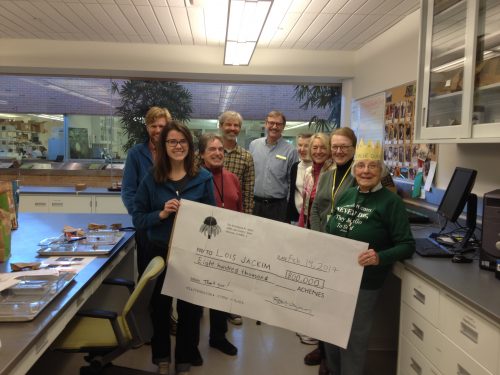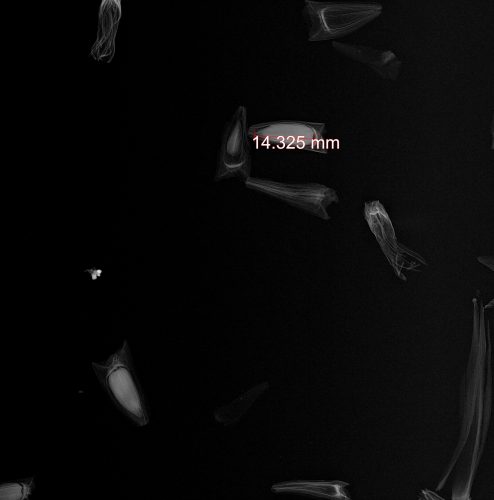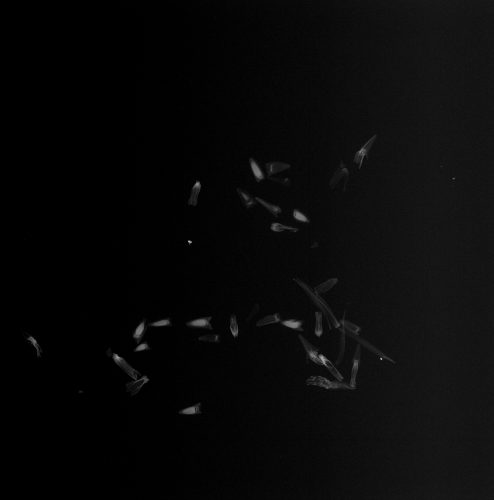|
|
Lois Jackim, citizen scientist working on Team Echinacea since 2009, counted her 800,000th Echinacea achene this morning around 9:30 AM. Scientists from the Chicago Botanic Garden and Northwestern University were present as Lois was presented with a giant check thanking her for her dedication to plant science and conservation. Lois wore her “Achene Queen” crown, which she earned in 2015 after surpassing the half-million mark. Lois was not aware she was so close to the 800,000 milestone.
Counting fruits, also known as achenes in Echinacea, is a critical activity for scientists measuring reproductive fitness of plants. The Echinacea Project conducts experiments to assess environmental and genetic factors that influence plant fitness. Echinacea Project research contributes to basic ecological and evolutionary science in addition to informing conservation of perennial plants and prairies.
Other citizen scientists present this morning were cleaning and preparing seedheads and making digital images for counting. Each year the Echinacea project harvests heads from experimental plots and volunteer citizen scientists at the Chicago Botanic Garden count all achenes from each head. Citizen scientists also x-ray samples of achenes from each head to count how many of the achenes were pollinated.
 Team Echinacea celebrates Lois counting 800,000 achenes  Stuart presents Lois with a giant check to thank her for counting over 800,000 achenes.

Team Echinacea lost one of our longtime members, Bill Wallin. Last week Bill went to the hospital for pain associated with cancer and his health deteriorated quickly. He died on Monday surrounded by his family.
We will miss Bill a lot. He volunteered on Thursday mornings and has been an integral part of our team for over a decade. He was a hard working and dedicated citizen scientist and a great person to have in the lab. He was thoughtful and considerate and contributed to the ongoing discussions in the lab on wide-ranging topics. Bill was usually soft spoken and quick to smile. He would share stories of his adventures with pianos and more recently of his cancer. Through thick and thin, we could count on Bill to be a positive influence on the Team.
Bill contributed to all aspects of lab work with the Echinacea Project. In the past several years, Bill focused on counting achenes. We appreciated Bill for his speed and accuracy when counting. Since we moved to our online seed counting system in 2011, Bill has counted over 413,430 Echinacea achenes. Before joining the Echinacea project, Bill pulled weeds in natural areas at the Garden and monitored threatened plants for the Plants of Concern Program.
We will miss Bill, but we are grateful that we got to work with him and enjoy camaraderie while making contributions to plant science and conservation. We will forever have great memories.
Here is Bill’s profile from 2015 and some more posts with photos of the team and of Bill.
 Roxy, a loyal companion to Team Echinacea during our summers in Minnesota, died today. She led a long and full life: running, digging holes & trenches, enjoying the companionship of people, eating smelly things, licking skunky gravel, basking in the sun, and chasing many critters, including chipmunks, 13-lined ground squirrels, rabbits, gray squirrels, fox squirrels, raccoons, ducklings, mice, red squirrels, and pocket gophers. She will be greatly missed. Roxy, a loyal companion to Team Echinacea during our summers in Minnesota, died today. She led a long and full life: running, digging holes & trenches, enjoying the companionship of people, eating smelly things, licking skunky gravel, basking in the sun, and chasing many critters, including chipmunks, 13-lined ground squirrels, rabbits, gray squirrels, fox squirrels, raccoons, ducklings, mice, red squirrels, and pocket gophers. She will be greatly missed.


Stuart recommends the below books as a good place to start thinking about time management. If you aim to manage time to better reflect your values, these books can help you develop strategies. The locations refer to NU libraries.
Mindset : the new psychology of success / Carol S. Dweck.
Dweck, Carol S., 1946-
New York : Random House, ©2006, 1st ed..
Checked out from Main Library Stacks (153.8 D989m )
Thinking, fast and slow / Daniel Kahneman.
Kahneman, Daniel, 1934-
New York : Farrar, Straus and Giroux, 2011, 1st ed..
Available at Qatar Library Stacks (BF441 .K238 2011 ) and other locations
Getting things done : the art of stress-free productivity / David Allen.
Allen, David, 1945 December 28-
New York : Viking, 2001
Available at Main Library Stacks (646.7 A425g ) and other locations
Succeed : how we can reach our goals / Heidi Grant Halvorson ; foreword by Carol S. Dweck.
Halvorson, Heidi Grant-, 1973-
New York : Hudson Street Press, ©2010
Available at Main Library Stacks (153.8 G762s )
Power of habit : why we do what we do in life and business / Charles Duhigg.
Duhigg, Charles, author.
New York : Random House Trade Paperbacks, 2014, Random House Trade Paperback edition..
Checked out from Main Library Lending Resource Sharing Requests (BF335 .D78 2014 )
Willpower : the rediscovery of humans’ greatest strength / Roy F. Baumeister and John Tierney.
Baumeister, Roy F.
New York : Penguin Press, 2011
Checked out from Main Library Stacks (153.8 B347w )
While looking for some information about the establishment of the Stipa experiment, I encountered an x-ray image of a few Stipa propagules (Hesperostipa spartea). Check it out…
 An x-ray image of a Stipa propagule (Hesperostipa spartea)
I also found some x-ray images of Echinacea angustifolia achenes. There are higher resolution images than the ones we now take for data analysis.
 An x-ray image of achenes & other stuff from an Echinacea angustifolia head with higher magnification
 An x-ray image of achenes & other stuff from an Echinacea angustifolia head  An x-ray image of achenes & other stuff from an Echinacea angustifolia head
Today we recorded first flowering dates for the early-flowering Echinacea plants in our remnant populations. For short, we call this activity “phenology.” Now we want to estimate how many total plants will flower this year at each site.
At four remnants (eri, sap, yohe, and lfw), we also recorded as many plants as we could find in bud. The ratio of currently flowering plants (flPla), to all plants in bud (allPla) at these sites ranged from 9 – 27%.
The below table shows the estimates (guesses) of how many plants will flower at each site this summer based on the assumption that 10% (guessHigh) and 25% (guessLow) of plants at each site are already flowering.
> aa[order(aa$guessLow), ]
site proFl allPla flPla guessLow guessHigh
12 nwlf 0.00 2 0 0 0
16 rrxdc 0.00 2 0 0 0
20 tower 0.00 1 0 0 0
23 woody 0.00 1 0 0 0
5 gc 0.50 2 1 4 10
17 sgc 1.00 1 1 4 10
10 lcw 1.00 2 2 8 20
11 nrrx 1.00 2 2 8 20
22 tplot 0.50 4 2 8 20
25 yohw 0.67 3 2 8 20
3 eri 0.09 33 3 12 30
6 kj 1.00 3 3 12 30
15 rrx 0.43 7 3 12 30
21 th 0.75 4 3 12 30
24 yohe 0.22 18 4 16 40
1 aa 0.56 9 5 20 50
19 sap 0.19 26 5 20 50
4 eelr 0.54 13 7 28 70
18 sppe 0.57 14 8 32 80
2 alf 0.50 20 10 40 100
13 on27 0.60 25 15 60 150
8 lfw 0.27 74 20 80 200
7 lfe 0.39 62 24 96 240
14 ri 0.44 54 24 96 240
9 lce 0.74 34 25 100 250
>
These estimates will help us decide which populations to choose for our planned systematic observations of bees this summer.
Read Rachael’s final paper, in which she investigates the extent to which flowering schedules differ between plants with only one head and plants with multiple heads.
Nina presented her poster “Competitive Exclusion Between Echinacea angustifolia and Echinacea purpurea” at the Illinois Math and Science Academy student research symposium (aka the 28th Annual IMSAloquium) on April 28th.
You can read all of the abstracts. She gave a great presentation. It was a pleasure to have Nina on the team.
On this day inaugural National Citizen Scientists’ Day, we acknowledge the hard-work and dedication of our team of Citizen Scientists in the Echinacea Project’s lab the Chicago Botanic Garden. Some of the citizen scientist members of our Team have been working on the project almost 15 years!
Read profiles of our fabulous citizen scientist Team members:
Aldo — — Anne — — — Art — — — Bill
Bob — — Char — — — Kathryn — — Laura
Leslie — — Lois — — — Lou — — — Marty
Naomi — — Shelley — — Suzanne — — Susan
Two humble volunteers declined to have profiles posted. We respect their privacy.
Read about some of the ways in which they contribute.
Read about what some of the activities from this past week.
Read many flog posts about our volunteer citizen scientists as written by members of Team Echinacea.
Taylor presented a poster of her summer research on fitness of native, non-native, and hybrid Echinacea plants at the Tennessee Louis Stokes Alliance for Minority Participation Conference. The meeting was held February 25-26, 2016 at the University of Tennessee-Knoxville. Taylor was awarded 3rd place in Science Poster Presentation category. Yay, Taylor!
|
|










